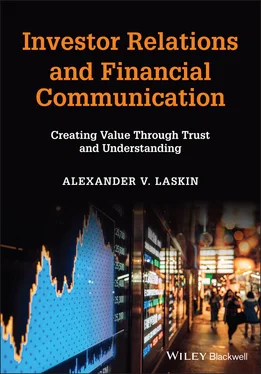(Morrill, 1995)
Laskin (2010a) concludes “public relations was set up to fail in investor relations – it just came too early” (p. 11).
The variety of new private shareholders was also quite a new experience for many corporations in the 1950s and created another incentive (along with the need to compete for capital) for the formation of investor relations departments. The new shareholders owned very small amount of stocks, and had very little understanding of business and finance, but the sense of ownership among them was great. These new shareholders were proud to own just one or two shares of a corporation and craved information, yet because of their large numbers, it was difficult to communicate with all of them directly. The financial intermediaries who transmit large amounts of financial information today were not well developed in the 1950s. The private shareholders often owned the stock directly instead of through pension or mutual funds and had to be the direct targets of early investor relations communications.
In addition, the management did not want to take the private shareholders seriously or invest any effort in communicating with them. So, managers were looking for a way to communicate with these shareholders from a distance, to give them information without meeting with them in person, ideally without any chance for shareholders to respond or ask questions. Public relations was ready to oblige: “many have engaged public relations counsel, or similarly styled agencies who issue press releases” (Morrill, 1995). Today, hardly anyone would equate investor relations with media relations. Laskin (2009) claims that media relations is among the lowest priority tasks for today’s IROs. In the 1950s, however, press communications were a significant part of the investor relations job.
The corporations also did not have any interest in listening to their shareholders – the focus was on a one-way stream of information from the company to the financial publics. No feedback was received or analyzed. No dialogue was promoted. Nobody was listening.
As a result of this history, public relations became almost a derogatory term in investor relations. This was also a reason investor relations professionals started trying to actively distinguish themselves from public relations, and disassociate themselves from public relations education, professional associations, and consulting agencies. Cutlip et al. (2000) observe, “As press agents grew in number and their exploits became more outrageous – albeit successful, more often than not – it was natural that they would arouse the hostility and suspicion of editors and inevitable that the practice and its practitioners would become tainted. This stigma remains as part of the heritage of public relations” (p. 107).
This stigma remains strong in the financial world: “The word public relations became increasingly a pejorative in Wall Street” (Morrill, 1995). Financial publics lost any credibility they might have had in public relations practitioners, their ethics, integrity, or simply capabilities of handling investor relations. Investor relations engaged in significant efforts to distinguish itself from any public relations background. If initially joining the Public Relations Society of America (PRSA), a professional association for public relations practitioners, was considered, in the 1960s investor relations practitioners began talks about the need to create their own professional organization where the public relations “chaff” would not be allowed.
The association of investor relations practitioners, the Investor Relations Association (IRA), later NIRI, came about in 1967. It kept its promise and made every effort to differentiate its members from public relations practitioners by conducting strict background checks on all the applicants: “Our aim is to separate ourselves from the so-called financial public relations consultants, who operate on the fringe of stock touting, and who are fouling the nest” (Morrill, 1995).
Thus, in its earliest days investor relations began as a subset of public relations. However, it began at a time when public relations itself was rarely more than a press agentry. Lack of financial expertise, lack of ethics, and lack of strategic vision hurt investor relations at its early stages and moved the function away from public relations departments. Much of the public relations and communication expertise was voluntarily cut off and disregarded as unnecessary or even harmful in favor of financial and accounting expertise.
The 1970s saw the shift from individual retail investors to institutional investors.
On one side, the enormous growth of investment activities in the 1950s and 1960s put pressure on the financial market infrastructure. The growth in individual investors was exponential in the years after World War II: from 4.5 million people in 1952 to over 20 million people in 1965, which represented every sixth adult in the United States. Chatlos (1984) explains:
As the trading and brokerage system creaked and strained under the increasing load of activity imposed on it, Wall Street’s response was less than prudent. Profitable success after success as “the only game in town” proved to be a harsh taskmaster to the system. When problems emerged because sale activities were extended beyond the back offices’ ability to handle the resulting volume, the immediate response was arrogant quick fixes rather than anticipatory long-term business planning.
(p. 87)
When it became painfully obvious that the system could not handle any more transactions, the response was a monopolistic one. Banks stopped taking on any new clients. Brokers became particular in choosing who to work with or whom to drop from the client list. The processing times were long, and the services were not friendly.
Another problem was the track record. The market was growing in leaps and bounds after World War II and shareholders (especially individual shareholders) expected it to continue like this forever. The expectations became too high for the reality to deliver. In other words, “success bred a level of expectations that could not be fulfilled” (Chatlos, 1984, p. 87). The system was destroying itself: the system built on volume of transactions could not handle that volume anymore, and the investors were ready to quit:
Customers were less than happy and did what might have been expected. They walked away. They did not sell their shares. They just walked away. For a system geared to the retail trade – and in many respects it remains so today – it was a devastating blow. The system was geared to volume, couldn’t plan for high volume, and suddenly had very little volume. Again, as could have been expected, broker failures and bankruptcy-avoiding mergers followed. It was a grim sight and the individual shareholder moved further away from the system.
(Chatlos, 1984, p. 87)
Professional investors began replacing retail investors. Consolidation was the name of the game. It was time to take all these retail investors with just a few thousand dollars and pull them together in investment funds. Although mutual funds existed for years, they really became popular only in the 1970s as more and more investors entrusted their cash to the fund managers. The first ever index fund available for individual investors, First Index Investment Trust (Vanguard 500), was launched in 1976 by the Vanguard Group as a response to the changing market demands.
This, however, meant a change for investor relations – instead of retail shareholders they would now face professional investors. Instead of less than knowledgeable individuals, overqualified stock analysts became the main contacts for the IROs The whole expertise previously geared toward private retail shareholders was becoming less and less relevant. Communications through mass media to reach large crowds of retail shareholders or conducting majestic special events to put the company’s name out there were not appropriate anymore: “Because of the legal fiduciary responsibilities to their clients, these institutions have demanded detailed and timely strategic and financial information” (Higgins, 2000, p. 24). They could not be satisfied by gift baskets or tours of company headquarters – they demanded detailed information on the company’s financial performance.
Читать дальше











